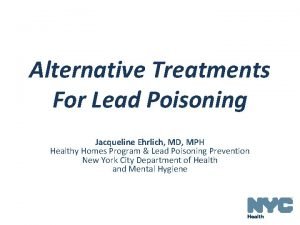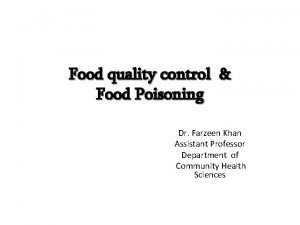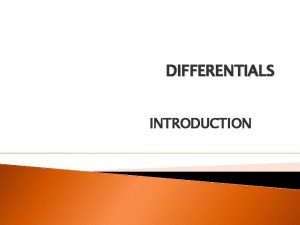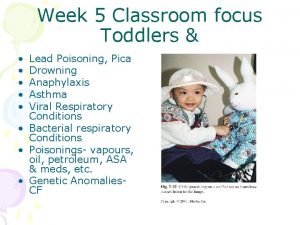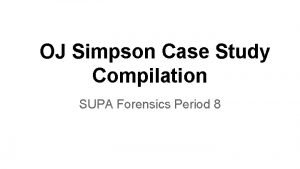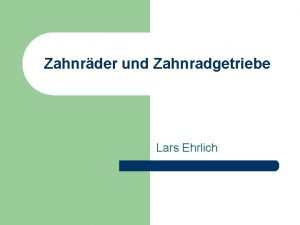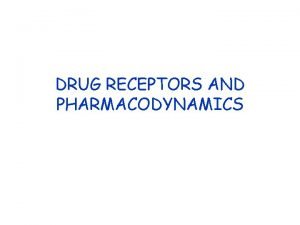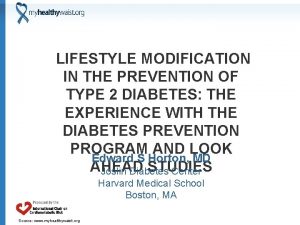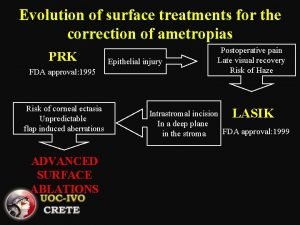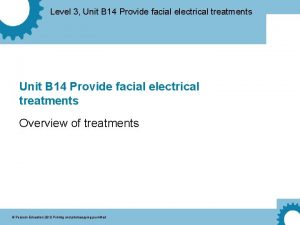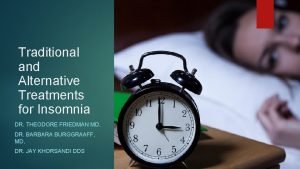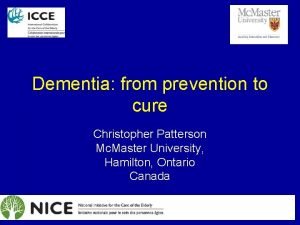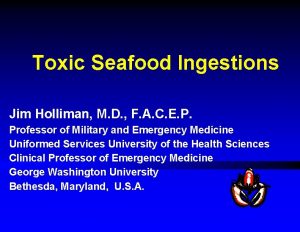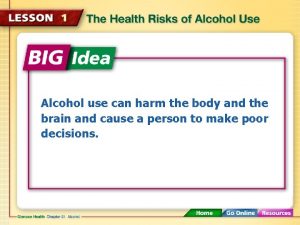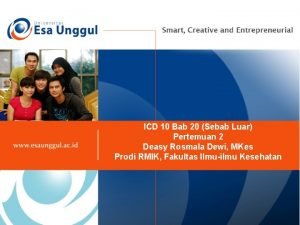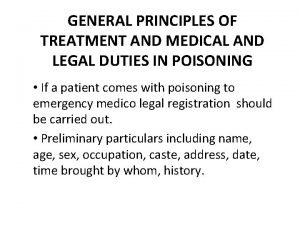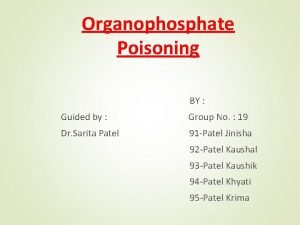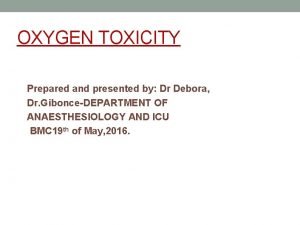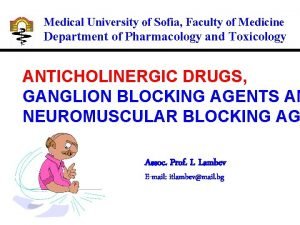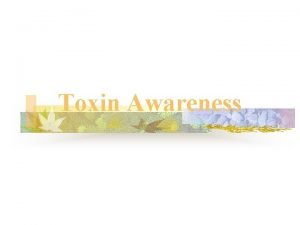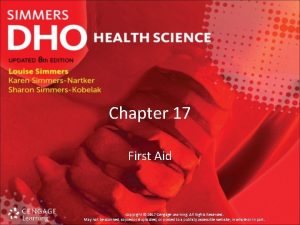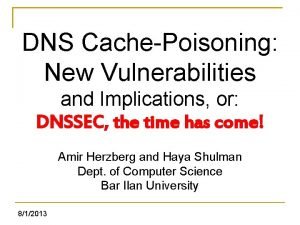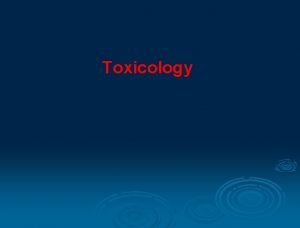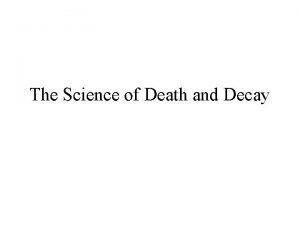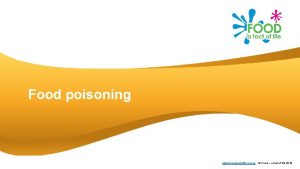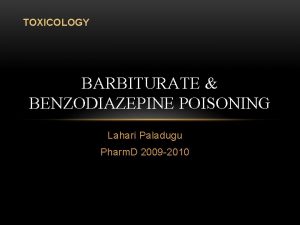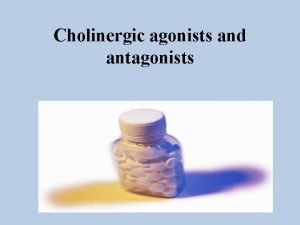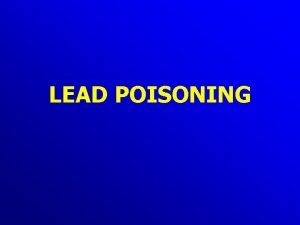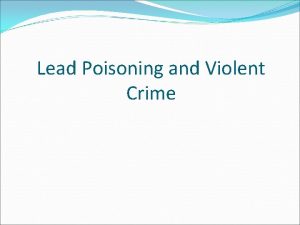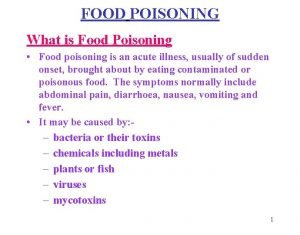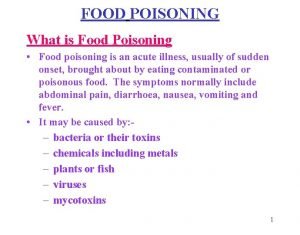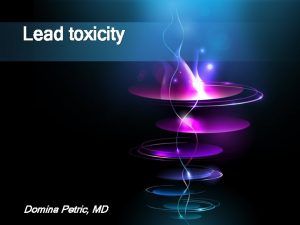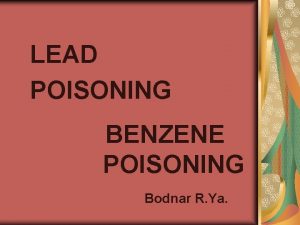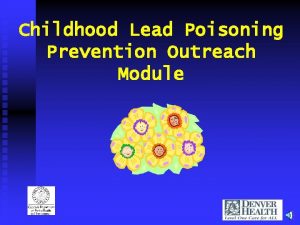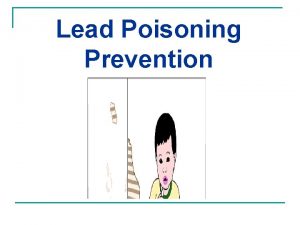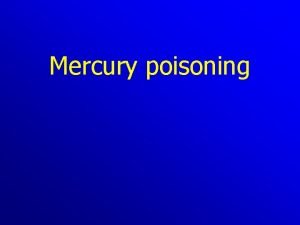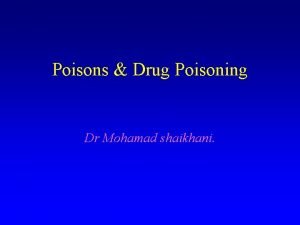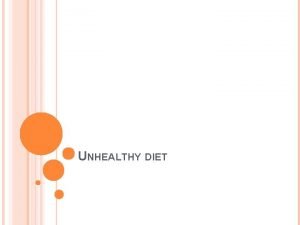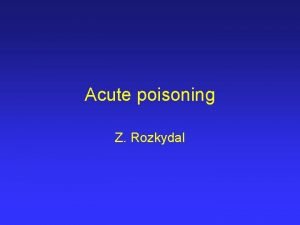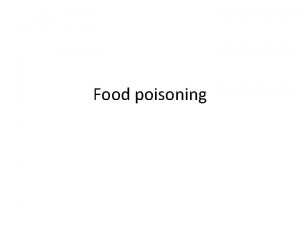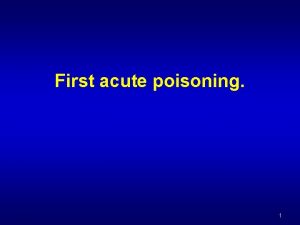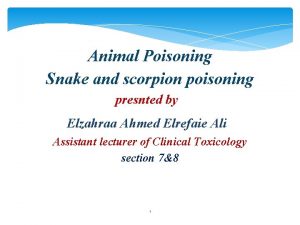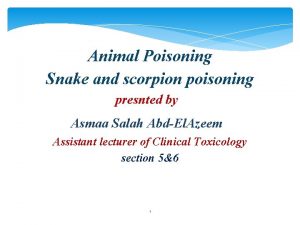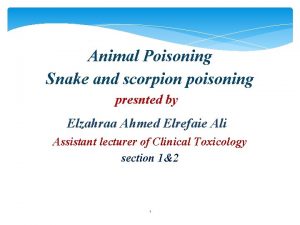Alternative Treatments For Lead Poisoning Jacqueline Ehrlich MD








































- Slides: 40

Alternative Treatments For Lead Poisoning Jacqueline Ehrlich, MD, MPH Healthy Homes Program & Lead Poisoning Prevention New York City Department of Health and Mental Hygiene

Chelation for BLLs > 45µg/d. L Remains Standard Therapy • 4 chelating agents currently available: – Dimercaprol or British Anti. Lewisite (BAL) – Ca. Na 2 EDTA or Ethylenediaminetetraacetic acid – Succimer or 2, 3 meso dimercaptosuccinic acid (DMSA) – D Penicillamine • Different side effects & risks to each agent • Lifesaving for patients presenting with encephalopathy • No evidence it improves IQ or behavior • Mobilizes lead at accelerated rate • Currently only recommended for BLLs > 45µg/d. L in children & pregnant women in second half of pregnancy http: //www 1. nyc. gov/assets/doh/downloads/pdf/lead chelation. pdf

Treatment for Lead Poisoning • Chelation therapy remains the standard • Market for over the counter chelating agents & alternative remedies created due to: – Side effects of these agents & – Increasing costs of these agents – Unconventional usage to treat autism • During this talk, safety & utility of numerous remedies will be reviewed

Remedies Espoused on the Internet • • • Vitamins & Minerals Herbs, Berries and Fruits Amino Acids Homeopathic Low fat Diet Over the counter/Internet Chelating Agents

Nutrition and Lead • Human body’s nutritional status may affect absorption, deposition & excretion of lead as well as its toxicity • Existence of potential nutrient lead interactions suggests optimizing nutritional status may assist in preventing consequences of lead exposure • Physiological mechanisms for potential nutrition lead interactions include nutrients: – – – Binding lead in the gut, Competing with lead for absorption, Altering intestinal cell avidity for lead, Altering affinity of target tissues for lead In tissues as antioxidants or anti inflammatory agents • Because of limited randomized, controlled experiments of nutritional interventions in children and pregnant women with EBLLs, most recommendations based on: – Generally accepted nutrition principles – Results of non pregnant adult, animal or cross sectional studies

Vitamins and Minerals

Calcium For Pregnant Women • Competes with lead for enzyme systems & can inhibit its absorption & bioavailability. • Increased lead absorption & tissue retention among overtly Ca deficient experimental animals confirmed in multiple species. • Confirmation of impact of low dietary Ca intakes also found among human subjects with increased lead absorption when diets low in Ca • Ca 1, 200 mg at bedtime during 3 rd trimester of pregnancy shown, in randomized crossover trial, to reduce maternal bone resorption by 14%, suggesting Ca supplements may reduce maternal bone lead mobilization during 3 rd trimester. • Ca supplementation associated with modest reductions in BLLs both during pregnancy & lactation. Suppression of bone resorption most likely mechanism, although reduced absorption from GI tract may contribute. • For pregnant & lactating women with BLLs ≥ 5μg/d. L or history of lead exposure, 2, 000 mg of calcium daily should be maintained either through diet or in combination with supplements. CDC. Guidelines for the Identification and Management of Lead Exposure in Pregnant and Lactating Women (2010)

Calcium for Children 1 • Little evidence child typically considered at risk for lead exposure at greater risk for low calcium intake than children without EBLLs. • However, because of frequency of inadequate intake among children, important to verify child with EBLL receiving enough Ca. • Results of both animal & human studies provide good evidence dietary calcium competitively inhibits lead absorption. – Results of one cross sectional study of older children with controls for SES show inverse association between dietary calcium intake & BLLs. – Limited studies evaluating Ca supplementation in young children with low Ca intakes & EBLLs showed inconsistent results in lowering BLL after 3 m 2 – Results of studies among older children & adults, animal studies & cross sectional studies all reinforce importance of adequate calcium intake. – However, no clinical evidence supplementation of calcium beyond recommended level in children with EBLLs has a clinical effect on the BLLs; • Therefore, calcium supplementation in children with EBLLs not recommended beyond Adequate Intake levels. 1. Managing Elevated Blood Lead Levels Among Young Children: Recommendations from the Advisory Committee on Childhood Lead Poisoning Prevention, Centers for Disease Control & Prevention, Atlanta 2002. 2. Markowitz ME, Sinnett M, Rosen JF. A randomized trial of calcium supplementation for childhood lead poisoning. Pediatrics. 2004 Jan; 113(1 Pt 1): e 34 9

Iron for Pregnant Women • Studies of effect of iron supplementation in lead poisoned pregnant women not available • Iron supplementation in pregnant & lactating women should be consistent with those given for pregnancy & lactation • No additional iron supplementation recommended for women with EBLLs • Iron status should be evaluated & supplementation provided to correct any deficiency CDC. Guidelines for the Identification and Management of Lead Exposure in Pregnant and Lactating Women (2010).

Iron for 1 Children • Although may help prevent lead absorption in animals, studies of association between Fe deficiency & BLLs in children produced inconsistent results. • Fe deficiency associated with increased BLL age 12 m. 2 • Fe supplements in children with EBLLs & Fe deficiency shown to improve developmental scores, suggesting effects on cognition partially reversible • Finding consistent with data indicating neurodevelopmental impairment in children with Fe deficiency anemia partially resolved with Fe supplements. • Since effects of Fe deficiency on development appear independent of effects of lead, no reason to treat children with lead exposure differently • Giving children iron supplements not recommended except when iron deficiency or anemia documented • Iron supplementation should not occur during oral chelation therapy. 3 1. Managing Elevated Blood Lead Levels Among Young Children: Recommendations from the Advisory Committee on Childhood Lead Poisoning Prevention, Centers for Disease Control & Prevention, Atlanta 2002. 2. LM. Schell , M Denham, AD Stark, Julia Ravenscroft, Patrick Parsons, Elaine Schulte. Relationship between blood lead concentration and dietary intakes of infants from 3 to 12 months of age. Environmental Research. Vol 96, Issue 3, November 2004, p 264– 273. 3. Smith DR, Markowitz ME, Crick J, Rosen JF, Flegal AR. The effects of succimer on the absorption of lead in adults determined by using the stable isotope 204 Pb. Environ Res. 1994 Oct; 67(1): 39 53.

Vitamin C for Pregnant Women • • Suggested to act as natural chelating agent enhancing urinary elimination. Decreased lead retention shown in rats fed vitamin C & exposed to lead. Human subject studies also found Vit. C supplementation reduced BLLs. Cases of lead poisoned workers’ response to Vit. C in literature since 1939. Two large cross section al studies in adults found associations between BLLs & dietary intake or serum levels of vitamin C. In NHANES III, for >15, 000 adults, adults in highest 2 serum vit C tertiles had 65% 68% lower prevalence of EBLLs compared to lowest tertile. For >4, 000 NHANES III women (20 49 years), women with high serum vit C levels had 2. 5 lower odds of having BLLs in highest decile (>4µg/d. L). Among postpartum women in Mexico City, higher intakes of vitamin C associated with lower levels of breast milk lead. • Research suggests vitamin C may lower BLLs. However, dose unclear. Since studies conducted had small subject numbers & did not include pregnant women, further research needed. CDC. Guidelines for the Identification and Management of Lead Exposure in Pregnant and Lactating Women (2010).

Vitamin C for Children • Less known about effect of vitamin C on BLLs in children – One cross sectional study using NHANES III data showed high levels of serum vitamin C associated with low prevalence of EBLLs for both children & adults. – Results showed association between serum vitamin C levels & log BLLs among adults but not among children. – Did not control for environmental lead risk or include kids < 4 y. • Although evidence to support giving vitamin C to non pregnant adults with EBLLs, insufficient evidence to recommend supplementation for children with EBLLs. • Advise providing children adequate intake of vitamin C Managing Elevated Blood Lead Levels Among Young Children: Recommendations from the Advisory Committee on Childhood Lead Poisoning Prevention, CDC, Atlanta 2002.

Vitamin D • 2013 study of 90 battery manufacture workers selected & divided in 3 groups of 30 workers each depending on duration of lead exposure: – – – Group I—exposure 1– 5 years, Group II—exposure 6– 10 years and Group III—exposure more than 10 years. 30 age matched healthy control subjects taken for comparison. BLLs and serum vitamin D inversely correlated. 1 • Because data on association of lead & vitamin D limited, no specific recommendation made for supplementation of vitamin D in lead poisoned pregnant women or children. 2 • Adequate levels of vitamin D should be maintained. 1. Nilima N. Dongre, Adinath N. Suryakar, Arun J. Patil, Indira A. Hundekari, and Basavaraj B. Devarnavadagi. Biochemical Effects of Lead Exposure on Battery Manufacture Workers with Reference to Blood Pressure, Calcium Metabolism and Bone Mineral Density. Indian J Clin Biochem. 2013 Jan; 28(1): 65– 70. Published online 2012 Jul 27. 2. CDC. Guidelines for the Identification and Management of Lead Exposure in Pregnant and Lactating Women (2010).

Zinc • Competes with lead for binding sites on some enzymes, such as delta aminolevulinic acid dehydratase. • Zinc deficiencies, may increase both lead absorption & toxicity • Some evidence from animal studies suggests high levels of dietary zinc inhibit absorption & retention of lead in animals. • However, in one small clinical study, zinc given with & without vitamin C to lead exposed workers zinc had no demonstrable effect on BLLs • Most American diets have sufficient sources of zinc • Thus, adding zinc supplements to diet of pregnant women or children with EBLLs not recommended. Managing Elevated Blood Lead Levels Among Young Children: Recommendations from the Advisory Committee on Childhood Lead Poisoning Prevention, CDC, Atlanta 2002.

Selenium (Se) • Possible role on oxidative stress induced by lead unclear. One possible mechanism as cofactor for glutathione peroxidase (GPx), an antioxidant enzyme • 2016 study explores associations among Se levels, chronic lead exposure, oxidative stress & parameters of antioxidant defense system in men occupationally exposed to lead. • Based on median serum Se concentrations, 324 study subjects divided into two subgroups: – Subgroup with a low Se level (L Se) and – Subgroup with a high Se level (H Se). • Lower serum Se associated with 6% higher BLLs and more oxidative stress indicated by higher lipofuscin level (pigment recognized as aging hallmark) • In low Se group, antioxidant defenses decreased (GSH level & GPx activity) • Studies limited and inadequate to recommend Se supplementation for lead exposure at higher doses than in a normal diet except for selenium deficiency. Pawlas N, Dobrakowski M, Kasperczyk A, Kozłowska A, Mikołajczyk A, Kasperczyk S. The Level of Selenium and Oxidative Stress in Workers Chronically Exposed to Lead. Biol Trace Elem Res. 2016 Mar; 170(1): 1 8.

β-carotene • Red/orange/yellow pigment found in plants precursor of vitamin A & known antioxidant. • 2014 study to determine whether β carotene reduces oxidative stress & homocysteine level in workers chronically exposed to lead. • Exposed population included healthy male workers exposed to lead randomly divided into 2 groups (mean BLL 44µg/d. L). – 1 st group (N = 49) had no dietary supplements administered, – 2 nd group (N = 33) had beta carotene administered 10 mg/d x 12 w. • Markers of oxidative stress measured: levels of malondialdehyde (MDA) & homocysteine (Hcy) & activity of superoxide dismutase (SOD) & its isoenzyme EC SOD. Kasperczyk S, Dobrakowski M, Kasperczyk J, Romuk E, Prokopowicz A, Birkner E. The influence of beta carotene on homocysteine level and oxidative stress in lead exposed workers. Med Pr. 2014; 65(3): 309 16.

β-carotene Results • After supplementation, MDA level decreased 16% compared to baseline & reference group. Hcy level also decreased. • However, level of thiol groups significantly higher. Activity of SOD & EC SOD also higher compared to baseline & reference group. • Observed to have antioxidant action & exert some beneficial effects in lead poisoned workers. • Research conducted to date insufficient to recommend β-carotene supplementation.

Herbs, Berries & Fruits Numerous plant products have been shown to have antioxidant activity, and antioxidant vitamins, flavonoids, and polyphenolic compounds of plant origin are investigated as scavengers of free radicals & inhibitors of lipid peroxidation.

Garlic (Allium sativum) • Garlic (Allium sativum) is an herbal product considered to have chelating effect in some animal studies. • In controlled double blind clinical trial in Iran on 117 battery plant workers with lead poisoning, workers divided into 2 groups – Garlic powder 400 mg (=1200μg allicin =2 g fresh garlic) 3 x daily x 4 w – D penicillamine 250 mg, 3 x daily x 4 w • Mean BLLs reduced in both groups with no significant difference. ( 42. 6 to 34. 7μg/d. L in garlic group & 41. 7 to 31. 6μg/d. L in d penicillamine group) • Frequency of adverse effects significantly lower in garlic group compared to D penicillamine group. • Neurological signs & symptoms such as irritability, headache & decreased DTR decreased. • Garlic may be significantly effective in reducing BLLs in patients with chronic lead poisoning. Kianoush S, Balali Mood M, Mousavi SR, Moradi V, Sadeghi M, Dadpour B, Rajabi O, Shakeri MT. Comparison of therapeutic effects of garlic and d Penicillamine in patients with chronic occupational lead poisoning. Basic Clin Pharmacol Toxicol. 2012 May; 110(5): 476 81.

Cilantro (Coriandrum Sativum) • Leaves rich in vit A, C & K. Seeds significant amounts of fiber, Ca, Se, Fe, Mg & Mn. • 32 children aged 3 7 y, with lead exposed worker parent, randomly divided into 2 groups; Duration of fathers' exposure to Pb at work 9 ± 6 y – Test group received Cilantro extract & – Controls given placebos for 14 d • Blood & urine lead concentrations determined at study beginning & 14 d later. • BLL 16µg/d. L & urine Pb 10µg/d. L & renal lead clearance. 012 L/d at beginning of study. No differences between 2 groups. K. Deldar, E. Nazemi, M. Balali Mood, SA. Emami, AH. Mohammad Pour, M. Tafaghodi et al. Effect of Coriandrum sativum extract on lead excretion in 3 7 year old children. J Birjand Univ Med Sci. . 2008; 15 (3) : 11 19.

Cilantro Results • After 2 w use of Cilantro, mean BLL decreased, urine lead increased & renal excretion of lead increased. But similar changes in control group. • Increasing lead elimination in both groups may have been due to other factors like improvement in nutrition following education at study beginning • Study double blind, but some mothers may have realized the medicine was coriander & may have given it to placebo group. • Thus, cilantro does not appear effective in lead elimination, although previous animal experiment on mice reported it as effective.

Seabuckthorn Juice • Shrub found in China, Mongolia, Russia, northern Europe & Canada • Ripe fruit rich source of vitamins A, C, E, & K, carotenoids, & organic acids. Long history in Tibetan & Mongolian medicine in treatment of various diseases. • Examined effect of Hippophae rhamnoides L. (HRL) juice on lead induced memory impairment & neuronal damage in brains of Kunming adult mice. • In lead only group mice exposed to lead acetate 10 mg/kg for 20 d. – In water maze test, swimming time lengthened – Product of lipid oxidation malondialdehyde levels & neurotransmitter breakdown enzymes acetylcholinesterase & monoamine oxidase activity increased – Levels of catecholamine neurotransmitters norepinephrine (NE) , serotonin & 5 hydroxyindole acetic acid (HIAA) decreased Yanji XU, Guangzhe LI, Chunji HAN, Lianping SUN, Rongjie ZHAO, and Santian CUI. Protective Effects of Hippophae rhamnoides L. Juice on Lead Induced Neurotoxicity in Mice. Biol. Pharm. Bull. 28(3) 490— 494 (2005).

Seabuckthorn Juice Results • Then either no HRL, 20% HRL or 40 % given. In HRL groups: – Swimming time decreased in mice receiving 20% & 40% HRL – Malondialdehyde levels reduced in 20% & 40% HRL groups in dose dependent manner – Activities of acetylcholinesterase & monoamine oxidase decreased in 40% HRL group but not 20% HRL – Levels of NE, serotonin & 5 HIAA increased in 40% HRL group, but 20% HRL had no effect • Data suggest HRL juice may protect against lead-induced deficits in memory & changes in neuro-biochemical parameters in mice.

Coconut Water • Study in 2016 to determine effect of coconut water on hemato biochemical changes due to lead in wistar albino rats • 60 rats assigned to 4 groups – Lead 0. 10 g/l water daily intraperitoneal x 6 w – 75 ml coconut water daily x 6 w – lead 0. 10 g/l of water+ 75 ml coconut water daily x 6 w – healthy control group • In lead treated rats when compared to controls: – Mean RBCs, MCV, MCHC, RDW & PLT counts reduced – WBCs, TL, TG, HDL, LDL/HDL & TL/HDL increased EB JESUORSEMWEN, II EBIKERE, IN OZEDE, A F EGHOMWANRE. Hematobiochemical changes of lead Poisoning and amelioration with Coconut (Cocos nucifera L. ) Water in wistar albino rats J. Appl. Sci. Environ. Manage. March. , 2016 Vol. 20 (1) 89 – 94.

Coconut Water Results • In coconut water treated groups: • All hematologic values increased except MCV, MCHC, & RDW in coconut water only group. • All lipid values decreased, except HDL. • Reduction in RBC values might be due to decreased life span & increased fragility of RBCs & inhibitory effect of lead on RBC enzymes; Ability of coconut water to counteract might be because it contains iron & folate • Exposure to lead causes tissue inflammation & alters metabolism of cholesterol; Reductions in coconut water groups may be due to anti oxidant & anti inflammatory effects • Results indicate that coconut water may ameliorate effects of lead toxicity in rats. EB JESUORSEMWEN, II EBIKERE, IN OZEDE, A F EGHOMWANRE. Hematobiochemical changes of lead Poisoning and amelioration with Coconut (Cocos nucifera L. ) Water in wistar albino rats J. Appl. Sci. Environ. Manage. March. , 2016 Vol. 20 (1) 89 – 94.

Olive Leaves • Olive leaves have antioxidant capacity. • 2013 study to determine whether olive leaf extract can inhibit lead induced brain injury, & whether this effect is associated with antioxidant capacity. • First, lead acetate administered to mice intra gastric for 30 d. Then, mice given olive leaf extract at doses of 250, 500 or 1 000 mg/kg daily for 50 d. • Under transmission electron microscope, attenuated neuronal & capillary injury & reduced damage to organelles & matrix around capillaries in frontal lobe of cerebral cortex. Extract dose 1000 mg/kg greatest effect. • Spectrophotometry showed increased activities of SOD, catalase, alk phos & acid phos while reducing malondialdehyde content, in dose dependent manner. • Immuno histochemical staining revealed dose dependent decrease in apoptotic activator Bcl-2 -associated X protein (Bax) expression in cerebral cortex. • Thus, olive leaf extract may inhibit lead-induced brain injury by increasing antioxidant capacity & reducing apoptosis. Wang, Y. , Wang, S. , Cui, W. , He, J. , Wang, Z. , & Yang, X. (2013). Olive leaf extract inhibits lead poisoning induced brain injury. Neural Regeneration Research, 8(22), 2021– 2029.

Turmeric • 2006 Egyptian study on effects of lead acetate in diet on reduced glutathione (GSH), activity glutathione S transferase (GST), & lipid peroxidation in liver homogenate & bone marrow chromosomes of mice supplemented with turmeric or myrrh for 8 w. • 5 groups of Swiss male albino mice, 30 mice each – First group served as negative control – Second group received diet with lead acetate only and served as positive control – Other 3 groups received lead acetate AND 1% or 5% turmeric powder or 1% myrrh powder IM. El Ashmawy, KM. Ashry, Abeer F. El Nahas and OM. Salama. Protection by Turmeric and Myrrh against Liver Oxidative Damage and Genotoxicity Induced by Lead Acetate in Mice. C Basic & Clinical Pharmacology & Toxicology 2006, 98, 32– 37.

Turmeric Results • • Decrease in GSH in all treated groups compared with negative control. Activity of GST decreased & lipid peroxidation increased in lead group Administration of plants increased GST activity compared to both controls. Treatment with plants resulted in reduction lipid peroxidation level by – 31% & in mice receiving 1% turmeric – 49% in mice receiving 5% turmeric – 45% in mice receiving 1% myrrh • Reduced genotoxicity (reduction in #dividing cells, #aberrant cells & frequency of chromosomal aberrations) observed with 5% turmeric only. • Turmeric & myrrh may potentially help to control oxidative damage & genotoxicity induced by lead acetate. IM. El Ashmawy, KM. Ashry, Abeer F. El Nahas and OM. Salama. Protection by Turmeric and Myrrh against Liver Oxidative Damage and Genotoxicity Induced by Lead Acetate in Mice. C Basic & Clinical Pharmacology & Toxicology 2006, 98, 32– 37.

Contaminated Turmeric in NYC • During home visits for NYC lead poisoned children, based on risk assessments, DOHMH collects samples of potentially contaminated products • Since 2007, 227 samples of turmeric tested • 33% (76) samples with ≥ 10 ppm lead – Range 10 2000 ppm – Mean 627 ppm – 46 purchased in Bangladesh, 10 in US, 1 Morocco, 1 Pakistan, 1 India DOHMH unpublished data

Amino-acids

N-acetylcysteine (NAC) • Precursor to antioxidant glutathione • Possesses reactive groups, such as thiol, hydroxyl & amine, which can bind lead & remove it from the body. • Experimental studies with rats suggest oxidative stress induced by lead reduced by sulphur containing compounds. • 2015 study of 171 workers occupationally exposed to lead found those treated with NAC showed reduction in BLLs. • In addition, all groups receiving NAC had elevated activity of glutamate dehydrogenase. NAC normalized level of homocysteine & decreased oxidative stress. • NAC potential therapy for chronic lead toxicity Kasperczyk S, Dobrakowski M, Kasperczyk A, Romuk E, Rykaczewska Czerwińska M, Pawlas N, Birkner E. Effect of N acetylcysteine administration on homocysteine level, oxidative damage to proteins, and levels of iron (Fe) and Fe related proteins in lead exposed workers. Toxicol Ind Health. 2016 Sep; 32(9): 1607 18.

Taurine • Amino acid that can be manufactured by the body & known antioxidant • Best food sources are meat and fish. • 2004 study describes dose dependent effect of taurine (50 100 mg/kg daily x 5 d), either alone or in combination with DMSA (DMSA 50 mg/kg once daily x 5 d) in treatment of subchronic lead intoxication in male rats • Lead exposure produced inhibition of ALAD activity & reduction in GSH • Only DMSA increased ALAD activity; both taurine & DMSA increased GSH. • Animals treated with taurine reduced alterations in some parameters indicative of oxidative stress. – Byproduct of lipid peroxidation, thiobarbituric acid reactive substance levels reduced, while GSH level increased. – Activity of SOD increased in blood & brain of rats. • Concomitant administration of taurine with thiol chelators could play a role in abating toxic effects of lead. Further research needed. Flora SJ, Pande M, Bhadauria S, et al. Combined administration of taurine and meso 2, 3 dimercaptosuccinic acid in the treatment of chronic lead intoxication in rats. Hum Exp Toxicol 2004; 23(4): 157 66.

Other Remedies

Homeopathic: Plumbum metallicum • • 2011 Double blind randomized trial 131 Ajax battery plant workers in Bauru, São Paulo, Brazil Plumbum metallicum 15 c. H or placebo, orally for 35 days CH dilutions are centesimal (C) dilutions, using Hahnemann’s (H) method. – Mother tincture diluted to 1/100 & shaken vigorously. This dilution known as 1 CH. – When 1 CH diluted again, following same process, 1/ 10, 000 dilution results, or 2 CH. – This can then be diluted again to create 3 CH and so on. • % workers with ≥ 25% reduction in BLL same: 20. 3% in homeopathic group vs 21% in control group • Plumbum metallicum had no effect in reducing blood lead levels in leadexposed workers Padilha RQ, Riera R, Átallah AN. Homeopathic Plumbum metallicum for lead poisoning: a randomized clinical trial. Homeopathy. 2011 Jul; 100(3): 116 21.

Low-Fat Diets • Link between fat intake & BLLs primarily from animal experiments. • In one cross sectional study, researchers found a direct association between dietary fat & BLLs; • However, no such relationship found in NHANES II. • Thus, no strong case can be made for decreasing children’s total fat intake. • In addition, dietary fat important in diets of children under 2 y of age because calories from fat support high calorie requirements for growth during this period. • Thus, low-fat diets for the treatment of younger children with EBLLs not recommended.

Oral Chelating Agents • Already mentioned standard of care for children and women in 2 nd second half of pregnancy with BLLs ≥ 45µg/d. L typically include chelation • However, treatment with succimer to lower BLLs 20 44 in toddlers was not shown to improve cognition* • Lack of evidence to recommend lead chelation for children or pregnant women with BLLs <45µg/d. L *Xianchen Liu, MD, Ph. D; Kim N. Dietrich, Ph. D; Jerilynn Radcliffe, Ph. D; N. Beth Ragan; George G. Rhoads, MD; and Walter J. Rogan, MD. Do Children With Falling Blood Lead Levels Have Improved Cognition? Pediatrics 2002; 110; 787 791.

FDA Warning of Unapproved Chelation Products 10/14/10 • Increase noted in products marketed on internet claiming to cleanse body of toxic heavy metals & treat range of diseases, including ASD, cardiovascular dxs, Parkinson’s dx, Alzheimer’s dx, & macular degeneration • Come in various forms, including trans mucosal sprays, suppositories, capsules, liquid drops & clay baths • Have not been evaluated by FDA for tx of these dxs • Effectiveness in treating any dxs listed unsubstantiated • No FDA approved OTC chelation products. Only FDA approved chelating agents available by prescription for specific indications i. e. lead poisoning & iron overload • “These products are dangerously misleading because they are targeted to patients with serious conditions and limited treatment options, ” said Deborah Autor, director of Office of Compliance in FDA’s Center for Drug Evaluation & Research. “The FDA must take a firm stand against companies who prey on the vulnerability of patients seeking hope and relief. ” • 8 companies warned their products are unapproved drugs & violation of federal law to make unproven claims about these products http: //www. fda. gov/News. Events/Newsroom/Press. Announcements/ucm 229320. htm

FDA Warning Letters Sent to: • World Health Products, LLC: Detoxamin Oral, Detoxamin Suppositories • Hormonal Health, LLC: Kelatox Suppositories • Evenbetternow, LLC: Kids Chelat Heavy Metal Chelator, Bio Chelat Heavy Metal Chelator, Behavior Balance DMG Liquid, Alka. Life Alkaline Drops, Nutri. Biotic Grapefruit Seed Extract, Natur Leaf, Kids Clear Detoxifying Clay Baths, EBN Detoxifying Bentonite Clay • Maxam Nutraceutics/Maxam Laboratories: PCA Rx, PC 3 x, AFX, AD Rx, AN Rx, Anavone, AV Rx, Bio. Guard, BSAID, CF Rx, Cre. Ocell, Dermatotropin, Endotropin, GTF Rx, IM Rx, Keto Plex, Natural Passion, NG Rx, NX Rx, OR Rx, Oxy Charge, PN Rx, Ultra AV, Ultra Pure Yohimbe • Cardio Renew, Inc: Cardio. Renew & Cardio. Restore • Artery Health Institute, LLC: Advanced Formula EDTA Oral Chelation • Longevity Plus: Beyond Chelation Improved, Endo. Kinase, Viral Defense, Wobenzym N • Dr. Rhonda Henry: Cardio Chelate (H 870)

ASD Chelation Study • National Institute of Mental Health Clinical Trials Identifier: NCT 00376194 • First received: 9/13/06; Last updated: 9/17/13 • Chelation widely used to treat individuals with ASD, with some surveys estimating 1 in 12 children with autism have undergone chelation. • Widespread use reflects hypothesis ASD caused by exposure to thimerosal, an ethylmercury based compound used previously as vaccine preservative. • Prevalent use in contrast with lack of scientific or clinical evidence of efficacy. Support based on single case reports of benefits of DMSA. • Thus, double blind, randomized placebo controlled study among 120 children, 4 10 y with ASD on effects of DMSA on behavior proposed; • Objective to quantify differences in behavioral functioning between chelation treatment group and placebo control group. • Study withdrawn prior to enrollment https: //clinicaltrials. gov/ct 2/show/NCT 00376194

Future Research Only clinical trials employing randomized designs can determine whether modifying intake of specific nutrients will actually influence BLLs
 Detoxamin side effects
Detoxamin side effects Lead poisoning children
Lead poisoning children Common factors that can lead to food poisoning
Common factors that can lead to food poisoning Blood smear
Blood smear Subcostal retractions
Subcostal retractions Nero lead poisoning
Nero lead poisoning Ralf ehrlich
Ralf ehrlich Charles ehrlich oj simpson
Charles ehrlich oj simpson Getriebearten
Getriebearten Skaten conjugaison
Skaten conjugaison Spare receptors
Spare receptors Paul ehrlich
Paul ehrlich Frequency dependence of dielectric constant
Frequency dependence of dielectric constant Diabetes treatments
Diabetes treatments Urinalysis
Urinalysis Advanced surface treatments
Advanced surface treatments Alternating treatments design
Alternating treatments design Level 3 electrical facial
Level 3 electrical facial Insomnia treatments
Insomnia treatments Hiv treatments
Hiv treatments Dementia treatments and interventions near patterson
Dementia treatments and interventions near patterson Clupeotoxin
Clupeotoxin Alcohol poisoning
Alcohol poisoning Neminath hubballi
Neminath hubballi Icd 10 luka bakar derajat 1
Icd 10 luka bakar derajat 1 General principle of treatment of poisoning
General principle of treatment of poisoning Organophosphate toxicity
Organophosphate toxicity Oxygen poisoning
Oxygen poisoning Curare
Curare Dioxin poisoning
Dioxin poisoning Chapter 17:4 providing first aid for shock
Chapter 17:4 providing first aid for shock Dns cache poisoning attack tutorial
Dns cache poisoning attack tutorial Kori fisher
Kori fisher Prinso poisoning
Prinso poisoning Gamaxin powder poisoning
Gamaxin powder poisoning Dioxin poisoning
Dioxin poisoning Carbon monoxide poisoning
Carbon monoxide poisoning Foodafactof life
Foodafactof life Barbiturate poisoning
Barbiturate poisoning Oxygen therapy
Oxygen therapy Atropine hallucinations
Atropine hallucinations
